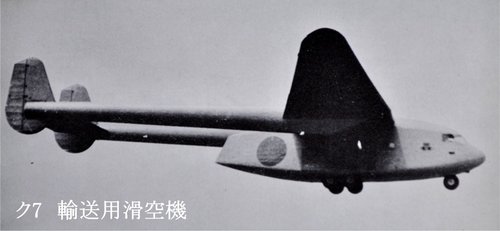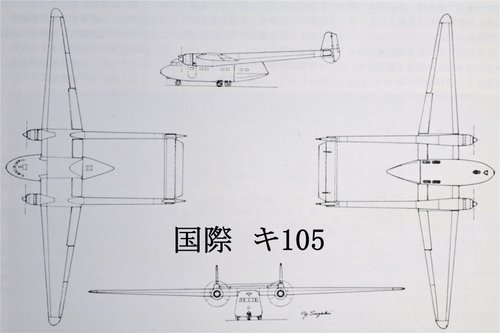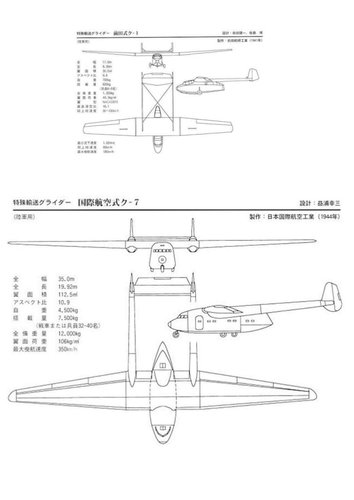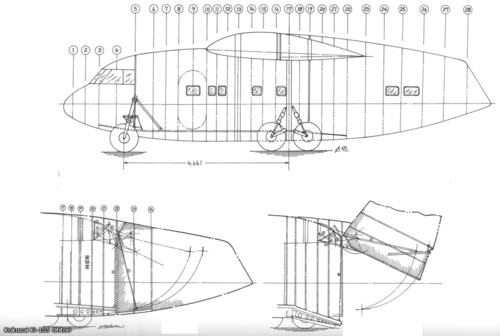You are using an out of date browser. It may not display this or other websites correctly.
You should upgrade or use an alternative browser.
You should upgrade or use an alternative browser.
Kokusai Ku-7 « Manazuru » and Ki-105 « Ohtori »
- Thread starter hesham
- Start date
- Joined
- 1 May 2007
- Messages
- 2,537
- Reaction score
- 1,752
The glider is the Kokusai Ku-7 Manazuru (Crane),
and the powered version is the Kokusai Ki-105 Ohtori (Phoenix),
From Putnam's 'Japanese Aircraft of the Pacific War', Rene J. Francillon, p.485
cheers,
Robin.
and the powered version is the Kokusai Ki-105 Ohtori (Phoenix),
From Putnam's 'Japanese Aircraft of the Pacific War', Rene J. Francillon, p.485
cheers,
Robin.
Attachments
windswords
ACCESS: Secret
- Joined
- 19 May 2009
- Messages
- 388
- Reaction score
- 207
blackkite
Don't laugh, don't cry, don't even curse, but.....
- Joined
- 31 May 2007
- Messages
- 8,597
- Reaction score
- 6,844
robunos said:What was the towing aircraft used for the Ku-7?
cheers,
Robin.
It looks like a Mitsubishi Ki-21 to me
blackkite
Don't laugh, don't cry, don't even curse, but.....
- Joined
- 31 May 2007
- Messages
- 8,597
- Reaction score
- 6,844
Oh sharp eyed guy.GTX said:robunos said:What was the towing aircraft used for the Ku-7?
cheers,
Robin.
It looks like a Mitsubishi Ki-21 to me
blackkite
Don't laugh, don't cry, don't even curse, but.....
- Joined
- 31 May 2007
- Messages
- 8,597
- Reaction score
- 6,844
Last edited:
blackkite
Don't laugh, don't cry, don't even curse, but.....
- Joined
- 31 May 2007
- Messages
- 8,597
- Reaction score
- 6,844
Ku-7 is a fork type tail military glider of the Imperial Japanese Army, which was prototyped during World War II. Design and manufacturing are by Japan International Aviation Industry. The nickname is "Manazuru". The Codename of the Allies is "Gander" (Gander, "Male Goose" and the meaning of "goofy").
The Ku-7 Glider was a enlarged type of Maeda Ku-1 Glider, which was ordered by the IJA in February 1942 as a "wooden glider capable of transporting Type 98 light tanks" to the Japan International Aviation Industry. Japan International Aviation Industry Co., Ltd. started the basic design in the same month with Kozo Masuura as the design manager, and in January 1943, the Ku-7I for strength testing was completed. Then, it began the production of Ku-7II as a practical type in response to the results of the strength test. The prototype of the Ku-7II was completed in July 1944, and it first flew on August 15, the same year.
The main fuselage and flight control surface of the Ku -7II was made of light alloy and otherwise made of wood. The fork type shape of the Ku-7II was able to secure a large square cargo compartment, which could be carried 32 - 40 personnel, 7,000 kg of cargo, or even light tanks. At the rear of the fuselage of the Ku-7II, it was equipped with a hydraulic upward opening door and a lower opening lifting plate, which became the standard in modern military transport aircraft. Ku-7II required a powerful towing aircraft, and it was scheduled to be filled with type-100 heavy bombers and type-4 heavy bombers, but these aircraft had few deployments. Since the development of the powered Ki-105 based on ku-7Ⅱ started, the development of Ku-7Ⅱ discontinued, only one Ku-7I and one Ku-7II was completed. It should be noted that, Ku-7II production was continued as Ki 105.
Ku-7Ⅱ specification
Length: 19.92 m, Span: 35.00 m, Height: 5.90 m, Wing area: 112.5 m2, Empty weight: 4,500 kg,
Payload: 7,500 kg, Maximum takeoff weight: 12,000 kg
Over-prohibition speed: 355 km/h (220 mph), Cruising speed: 200 km/h (125 mph)
Best glide ratio: 20:1, Crew: 2
Capacity: 32 - 40 persons or 7,000 kg of cargo
The Ku-7 Glider was a enlarged type of Maeda Ku-1 Glider, which was ordered by the IJA in February 1942 as a "wooden glider capable of transporting Type 98 light tanks" to the Japan International Aviation Industry. Japan International Aviation Industry Co., Ltd. started the basic design in the same month with Kozo Masuura as the design manager, and in January 1943, the Ku-7I for strength testing was completed. Then, it began the production of Ku-7II as a practical type in response to the results of the strength test. The prototype of the Ku-7II was completed in July 1944, and it first flew on August 15, the same year.
The main fuselage and flight control surface of the Ku -7II was made of light alloy and otherwise made of wood. The fork type shape of the Ku-7II was able to secure a large square cargo compartment, which could be carried 32 - 40 personnel, 7,000 kg of cargo, or even light tanks. At the rear of the fuselage of the Ku-7II, it was equipped with a hydraulic upward opening door and a lower opening lifting plate, which became the standard in modern military transport aircraft. Ku-7II required a powerful towing aircraft, and it was scheduled to be filled with type-100 heavy bombers and type-4 heavy bombers, but these aircraft had few deployments. Since the development of the powered Ki-105 based on ku-7Ⅱ started, the development of Ku-7Ⅱ discontinued, only one Ku-7I and one Ku-7II was completed. It should be noted that, Ku-7II production was continued as Ki 105.
Ku-7Ⅱ specification
Length: 19.92 m, Span: 35.00 m, Height: 5.90 m, Wing area: 112.5 m2, Empty weight: 4,500 kg,
Payload: 7,500 kg, Maximum takeoff weight: 12,000 kg
Over-prohibition speed: 355 km/h (220 mph), Cruising speed: 200 km/h (125 mph)
Best glide ratio: 20:1, Crew: 2
Capacity: 32 - 40 persons or 7,000 kg of cargo
blackkite
Don't laugh, don't cry, don't even curse, but.....
- Joined
- 31 May 2007
- Messages
- 8,597
- Reaction score
- 6,844
The Ki-105 was a prototype transport aircraft of the Imperial Japanese Army during World War II, and was developed and manufactured by Japan International Aviation Industry. The name “Ootori”, which is often introduced as the name of this aircraft, is an in-house name in Japan International Aviation Industry, and there are differences in notation depending on the literature. The code name by the US military is Buzzard.
From 1943 (Showa 18), the Japan international aviation industry has been developing the large-sized transport glider Ku-7II, but the Japanese Imperial Army which examined Ku 7-II completed in August 1944 (Showa 19) Instructed Japan International Aviation Industry to make this aircraft as transport aircraft with an engine. In a situation where the US Army's thorough trade destruction operations had taken its right to control seas in Southeast Asia, the Imperial Japanese Army replaced the oil tanker ship from the south to mainland Japan using segmented transportation with hundreds of transport aircraft. Also, they planned an extraordinary emergency measure to transport fuel as much as 20 percent.
At that time, as a request to the transport aircraft was raised as follows.
• 4t load or 40 troops can be transported.
• The cruising range is more than 1,500km.
• Mass production is possible.
The transport aircraft named Prototype Name Ki-105 was modified in the second prototype of Ku 7-II, and the prototype was completed in November 1944. The prototype had two engines, so the front of the fork-type fuselage was slightly extended. The central fuselage was made of light alloy and the other parts were wooden. As the fuel tank, a main tank was provided in the fork type fuselage, and an auxiliary tank was provided at the leading edge of the central wing. The engine was initially equipped with Ha 13 (450hp), but was replaced with Ha 26-II or Ha 102 due to insufficient output.
The result of the flight examination in December 1944 was good and mass production instructions to complete 300 aircraft by March 1945 were sent from the Imperial Japanese Army to Japan International Aviation Industry
In response to the army's mass production instructions, the mass production system was drawn mobilizing all the woodworking furniture factories around Kyoto (the elementary school auditorium was also used as a assembly place) by Japan International Aviation Industry, but production did not progress due to the intensification of air raids, shortage of supplies, and the decline in smelting by engineers and student mobilization, and only nine aircraft were completed by the end of the war due to the bombing of the production plant. The completed aircraft was used for training at Yakkaichi Airfield in Shiga Prefecture, but was destroyed by air raids (10 completed aircraft, there is also a opinion that the flight inspection ends 7 aircraft) remaining aircraft were also incinerated at the end of the war. In addition to the normal transport aircraft type (Ki -105 Ko), fuel transport type (Ki-105 Otsu) was also planned, but ended without completion by the end of the war.
If the development was carried out several years earlier and used as a strategic weapon, it would have been evaluated as one of the aircraft that could have a significant impact on the war situation , while it consumed most of the fuel from Southeast Asia, which was about 2,500 km away, to reach the mainland of Japan, and fuel was needed on the way from Japan to Southeast Asia. In addition, after the loss of air control, there is no guarantee that the slow and dull aircraft will be able to escape from allied fighters aircraft full of fuel, and there are negative opinions such as "in a desperate situation ... it does not seem almost insane".
Length: 19.92m, Span: 35.00m, Total height: 5.90m, Wing area: 112.5m2, Empty weight: 7,080-8,000kg
Gross weight: 10,380 to 12,500 kg,
Engine: Ha 26-II Air-cooled double-row radial 14-cylinder 940-950hp or Ha102 air-cooled double-row 14-cylinder 1050hp x 2
Propeller: Hamilton constant speed three blades D: 2.90m.
Cruising speed: 220-180km/h, Maximum speed: 270-300km/h (2,300m altitude)
Ceiling: 5,000m, Time to altitude: 6 minutes 16 seconds / 2,300m, Range: 1,500-2,500km
Crew: 4-5 + 40 soldiers, Load capacity: 3,300 to 4,500 kg

 doroshenko-us.livejournal.com
doroshenko-us.livejournal.com





From 1943 (Showa 18), the Japan international aviation industry has been developing the large-sized transport glider Ku-7II, but the Japanese Imperial Army which examined Ku 7-II completed in August 1944 (Showa 19) Instructed Japan International Aviation Industry to make this aircraft as transport aircraft with an engine. In a situation where the US Army's thorough trade destruction operations had taken its right to control seas in Southeast Asia, the Imperial Japanese Army replaced the oil tanker ship from the south to mainland Japan using segmented transportation with hundreds of transport aircraft. Also, they planned an extraordinary emergency measure to transport fuel as much as 20 percent.
At that time, as a request to the transport aircraft was raised as follows.
• 4t load or 40 troops can be transported.
• The cruising range is more than 1,500km.
• Mass production is possible.
The transport aircraft named Prototype Name Ki-105 was modified in the second prototype of Ku 7-II, and the prototype was completed in November 1944. The prototype had two engines, so the front of the fork-type fuselage was slightly extended. The central fuselage was made of light alloy and the other parts were wooden. As the fuel tank, a main tank was provided in the fork type fuselage, and an auxiliary tank was provided at the leading edge of the central wing. The engine was initially equipped with Ha 13 (450hp), but was replaced with Ha 26-II or Ha 102 due to insufficient output.
The result of the flight examination in December 1944 was good and mass production instructions to complete 300 aircraft by March 1945 were sent from the Imperial Japanese Army to Japan International Aviation Industry
In response to the army's mass production instructions, the mass production system was drawn mobilizing all the woodworking furniture factories around Kyoto (the elementary school auditorium was also used as a assembly place) by Japan International Aviation Industry, but production did not progress due to the intensification of air raids, shortage of supplies, and the decline in smelting by engineers and student mobilization, and only nine aircraft were completed by the end of the war due to the bombing of the production plant. The completed aircraft was used for training at Yakkaichi Airfield in Shiga Prefecture, but was destroyed by air raids (10 completed aircraft, there is also a opinion that the flight inspection ends 7 aircraft) remaining aircraft were also incinerated at the end of the war. In addition to the normal transport aircraft type (Ki -105 Ko), fuel transport type (Ki-105 Otsu) was also planned, but ended without completion by the end of the war.
If the development was carried out several years earlier and used as a strategic weapon, it would have been evaluated as one of the aircraft that could have a significant impact on the war situation , while it consumed most of the fuel from Southeast Asia, which was about 2,500 km away, to reach the mainland of Japan, and fuel was needed on the way from Japan to Southeast Asia. In addition, after the loss of air control, there is no guarantee that the slow and dull aircraft will be able to escape from allied fighters aircraft full of fuel, and there are negative opinions such as "in a desperate situation ... it does not seem almost insane".
Length: 19.92m, Span: 35.00m, Total height: 5.90m, Wing area: 112.5m2, Empty weight: 7,080-8,000kg
Gross weight: 10,380 to 12,500 kg,
Engine: Ha 26-II Air-cooled double-row radial 14-cylinder 940-950hp or Ha102 air-cooled double-row 14-cylinder 1050hp x 2
Propeller: Hamilton constant speed three blades D: 2.90m.
Cruising speed: 220-180km/h, Maximum speed: 270-300km/h (2,300m altitude)
Ceiling: 5,000m, Time to altitude: 6 minutes 16 seconds / 2,300m, Range: 1,500-2,500km
Crew: 4-5 + 40 soldiers, Load capacity: 3,300 to 4,500 kg
Kokusai Ki-105 Ohtori
Интересная нация все же Японцы. Во время Второй Мировой Войны, они разработали тяжелый транспортный самолет-танкер, для перевозки горючего. О нем сегодняшний рассказ. Самолет был создан на базе тяжелого транспортного планера Kokusai Ku-7. Планер был разработан в 1942 году. Он был способен перевезти…
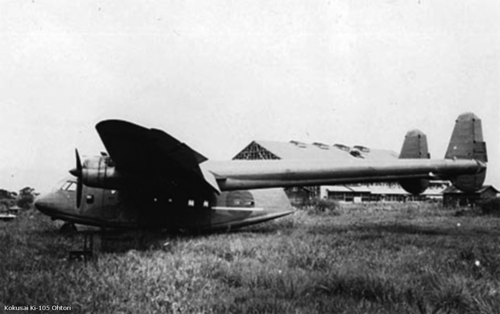
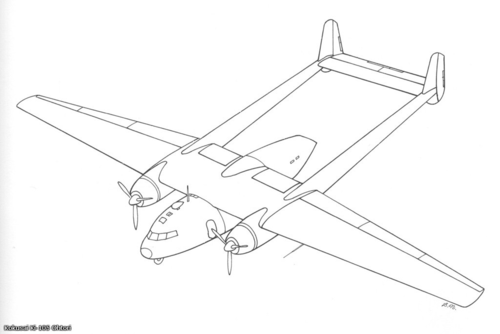
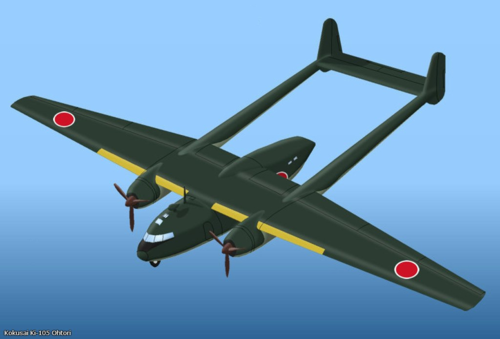
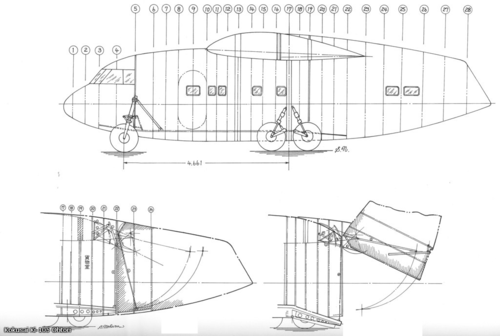
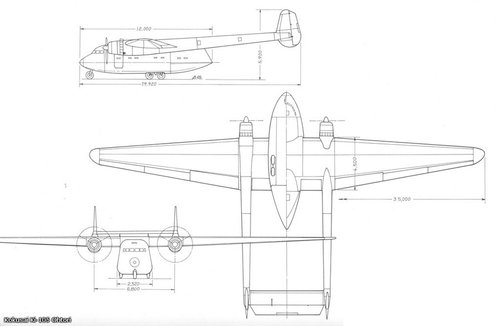
Last edited:
blackkite
Don't laugh, don't cry, don't even curse, but.....
- Joined
- 31 May 2007
- Messages
- 8,597
- Reaction score
- 6,844
Attachments
blackkite
Don't laugh, don't cry, don't even curse, but.....
- Joined
- 31 May 2007
- Messages
- 8,597
- Reaction score
- 6,844
日本陸海軍試作/計画機1924~1945 (図解 世界の軍用機史) (日本語) 単行本 – 1999/9 、野原 茂
ILLUSTRATED WARPLANE HISTORY THE XPLANES of IMPERIAL JAPANESE ARMY & NAVY 1924-45, ISBN4-7663-3292-X
Please try Amazon.(copy and paste book name)
Page 133 to 141, Many detailed drawings.
ILLUSTRATED WARPLANE HISTORY THE XPLANES of IMPERIAL JAPANESE ARMY & NAVY 1924-45, ISBN4-7663-3292-X
Please try Amazon.(copy and paste book name)
Page 133 to 141, Many detailed drawings.
Attachments
Last edited:
blackkite
Don't laugh, don't cry, don't even curse, but.....
- Joined
- 31 May 2007
- Messages
- 8,597
- Reaction score
- 6,844
Please try auto translator.
Temistocle
ACCESS: Secret
- Joined
- 9 December 2009
- Messages
- 219
- Reaction score
- 445
Similar threads
-
Kokusai Ki-76 artillery spotter/liaison aircraft: a Japanese "Storch"
- Started by blackkite
- Replies: 6
-
Mitsubishi Ki-2, Ki-2-II and Ohtori (Junkers K 37 derivatives)
- Started by blackkite
- Replies: 6
-
Terada aviation laboratory TK-3 transport
- Started by blackkite
- Replies: 2
-
-
Vakhmistrov Unknown Composite Aircraft Projects
- Started by hesham
- Replies: 13












